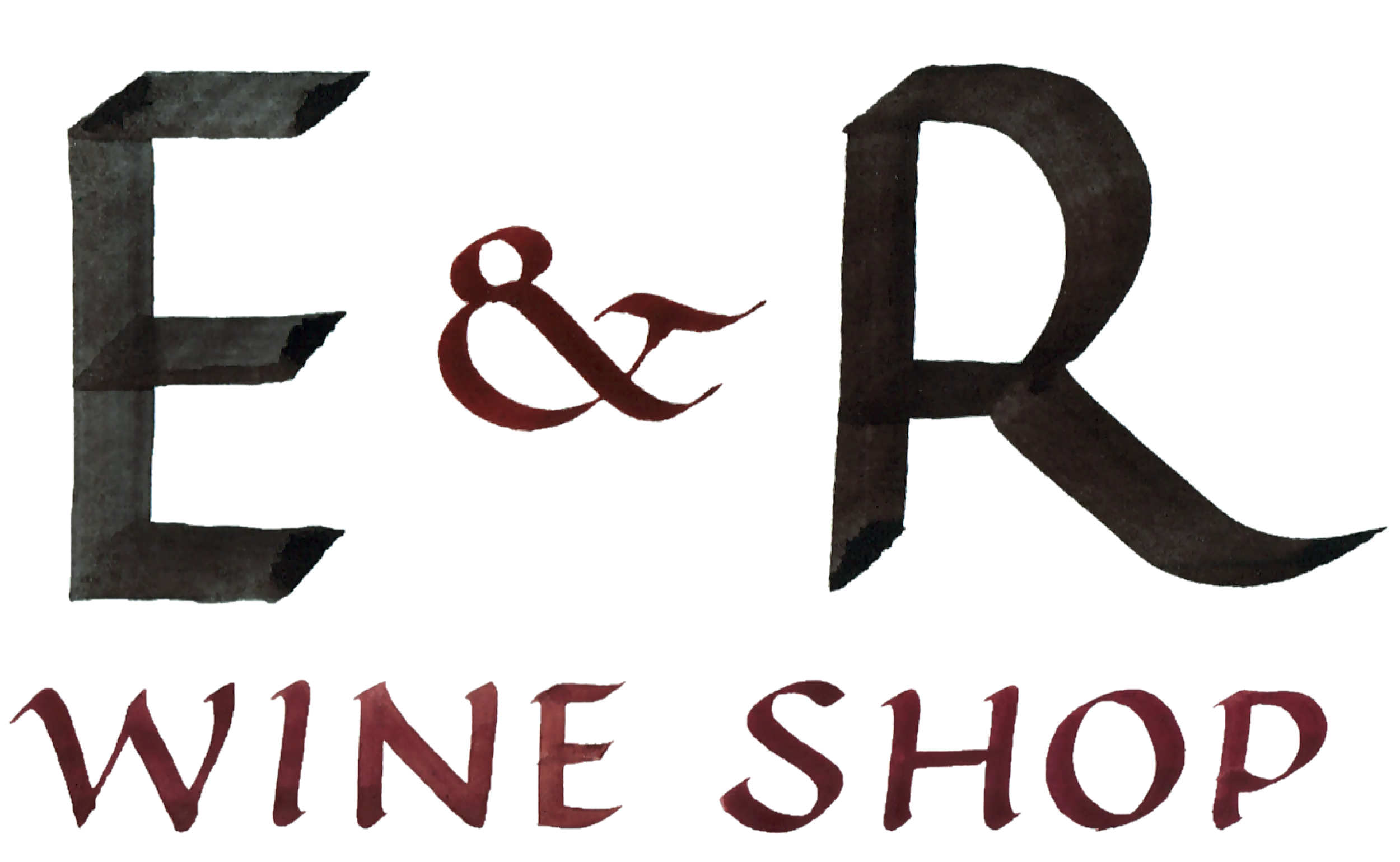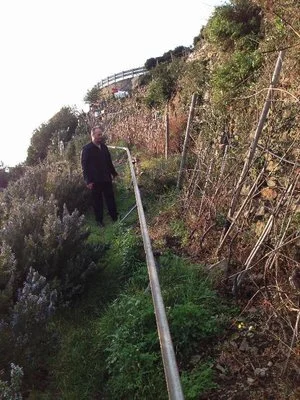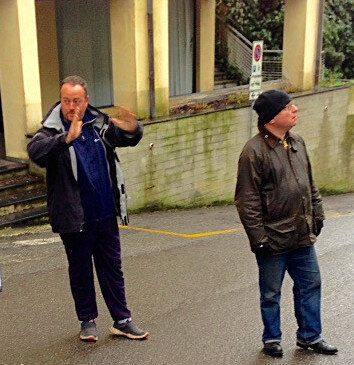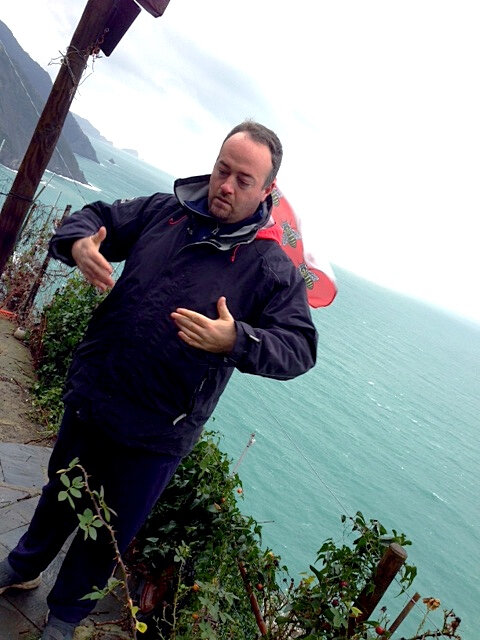La Possa - Cinque Terre, Italy
SAMUELE HEYDI BONANINI OF CINQUE TERRE (5 TERRE)
Samuele Bonanini in Riomaggiore is one of our favorite winemakers in the world. Our team has visited him eight times (most recently April 2022) and our admiration for his work and his wines grows and grows. This article has been and will continue to be updated though much of it is pivotal without regard to the timing of the article.
(January 8, 2013)
Even in those quick-sundown days in January winter, everywhere present is a scent of capers, valeriana and marjoram perfuming the sea breeze air. The iperico blooms amongst the scrub. Congregations of loose, free-resting rock think - weight leaned to gravity - of slinging the way, descending the few hundred displaced, chaotic, scenic yards to submerge and wobble down and through the swimming cuttlefish, anchovy, stone bass and pandora fish in the see-through blue Ligurian sea and to end below all that men can see. With its Bosco and Albarola grapevines, this steeplechase rock-ride terroir could only be the singular wine ground of "the real" Cinque Terre; home to wines that every one of last year's 345,187 tourists loved except one: one lone hold out. During the mid-afternoon, beams of the sun bounce off the mirror sea-surface in waving flags of bursting jewels. In the sundown eve, Riomaggiore bells chime out in a chorus of gonging and echo which floats cumulus-like above a choir of frogs and the constant splash of seawater on rock with a ghostly hush of searching, scented and quickly becoming chilly wind. Remove the bell echo and this night's unchanged since the year 500, during which the first wine growing evidence - in these hills of Possaitara-Chiappella, a little curve of hills above Riomaggiore - is documented.
I am with Samuele Heydi Bonanini, the H."B." Thoreau of the western coast of all of Italy. Samuele knows each of sixty something herbs that flourish and clothe his cliffs. He knows their individual scents, when they bloom, what they're useful for and how they aide his vines, interact with his bees and influence his well being. Dottore Samuele speaks of boiling robbia, valeriana assisting sleep, gathering agave for cuts, fennel bulbs being good for vision. Here the flora outcropped from the rock is rampant with thyme and tarragon and lavender, peppers black and red, cardoons waving, fragrant sage, salsify and finnochio, while the few wide enough sections of ground flats house lush trees of bay, lemon, honeydew, palm, myrtle, broom, grapefruit, fig and orange. His single file terraces are fenced in; why I ask? "The boar, they tear up the precious ground digging for earthworms". Nature, like Samuele, never takes a break. Samuele's practically single-handedly moved every stone into place on his oblivious-to-death, narrow walkways astride dovetailed and sometime crumbled five-foot-high terraces hundreds of yards above an aqua pale sea. He is carrying in and planting new fruit trees, building and rebuilding walls, planting new "vineyards"... and were there architect's renderings, you'd ask the obvious two questions; "who will do this work?" and "how can it be done?" There are no renderings, they are in Samuele's head; a part of his vision. The work shall be accomplished by him and a two-pronged team of himself and his passion.
Delivered rocks to haul by hand below to shore up the walls.
This is a long-short course in insane labor of love. Neither outdoes the other, his land and him, and at times they're one and the same. Samuele Heydi Bonanini is the kind of human being for whom we find open admiration and respect; he being not one of the many, but one of the few. For a fleeting moment you'd think you'd do the same if you could, if you had the time. If If If, and then you understand there is no way you could or you would. Yet you dream for a second, and like all our dreams, they are gone from you the next day - the zeal of it flown away - while the wonder for it all courses somewhere inside you with its subtle pulse in the veins.
Samuele is a guardian of what we are losing, and in this place so torrid, beautiful and unique. It is no wonder that the great man, Barolista Elio Altare, now retired and working harder than ever with his vineyard in Cinque Terre showed tears welling up in his eyes saying that all this, the true Cinque Terre, is being lost; there are no men like Samuele anymore. It is impossible. No one wants to do this work, and why? Why would they? Let these ridges and slopes all fall back to what they were years before 500AD. With Samuele Heydi Bonanini, it is not like he walks the walk; he IS the walk.
After a few surreal hours in this true dream-scape on our earth in his world of stone, spice, bees, nature-made huts, feathers, toads, heather, insects, birds, breeze and vine, only then did i get to taste Samuele's wines; his wines from the bosco grape and the albarola grape and the rossese bianco grape, only then - as the juice of the grapes from the ground we just hugged are now turned to an essence of place - am I certain that for the rest of my forever, the axis of my wine experience has turned a little, and i know i'll pass this all along as best as I'm able to fellow folk who love wine for what it can be when allowed to sing out in its own voice untampered with. For Samuele's place is another place, a different place, a strange and glorious place in our time and of another time. As one winemaker on this January Cinque Terre day told me "even the people who live here don't get it".
WHY CINQUE TERRE?
Perennially, restlessly we travel to discover tasty, original and new wines. It is not so much to say, ah, here is a remote region, lets go! We're to the point to say here's a less well-known region and within it is a tiny enclave of something even more potentially unique; lets go see and taste for ourselves. The Cinque Terre -" 5 Terre" as locals know it - is such a place for wine. And, it is not just anywhere, or another strip of beautiful vistas by the sea. The Cinque Terre is so unique the entire area is now a National Park and has been declared a World National Heritage Site by UNESCO. As the official UNESCO description is written, 5 Terre as a special place "contains superlative natural phenomena or areas of exceptional natural beauty and aesthetic importance", and is now protected to remain so permanently.
Threaded into the lower coast of boomerang-shaped Liguria, just below Piedmont and adjacent to Emilia-Romagna and Tuscany, the precipice-edged 5 Terre contain the five fishing villages of scenic Monterosso al Mare, flood wracked and wrecked Vernazza, Corniglia, Manarolo and Riomaggiore. The whole region is only about twelve miles from Monterosso al Mare in the north to Riomaggiore down south, though the intestine-like hill roads outlining the cliff edges will take nearly two hours to navigate by car. When coming from the north via Genoa you exit the crazy, twisty, hill-hugging Autostrada to drive the skinny lasso-like roads heading to the Cinque Terre. As you leave to the south toward Carrara where MIchelangelo carved out blocks of marble to sculpt his magical visions, you pass the little resort town of Lerici. Nearby, Percey Bysshe Shelley sailed out on his small boat one soon-to-be-stormy summer day only to have his drowned body wash ashore a day or so later at Lerici. His friend Lord Byron was there that day on that sad, trembling-grieved shore, while his other brother in verse, John Keats wanted to arrive eventually but never made it out of Rome, dying his Roman death. And some roads still lead to Rome where ironically now both Keats and Shelly rest together in time.
But... within the twelve miles of 5 Terre there exists a one of a kind world of wine. It's not even like the rest of Liguria, from which the still rare bottles of Vermentino are difficult to find on our shores; the 5 Lands twelve miles are considerably more remote even than that. Samuele explained there are about 20 different white grapes and four reds ones in Cinque Terre's minuscule DOC with the majority of wine from three indigenous white grapes; Bosco, Albarola and Rossese Bianco. A fraction of Cinque Terre wine comes from two superbly Ligurian red grapes: Canaiolo Nero and Bonamico. Most importantly, tiny 5 Terre is widely celebrated for one of the world's finest, most rare wines; Sciacchetra, a delicacy produced only there in proton-sized quantities. It is a true planetary treasure made from hand-picked and dried grapes.
Samuele is a wonderful host, guide and teacher. We spoke of many things during our time together and continue via e-mails. He is a man of the terraces; he's bright, energetic, serious and warm. He said when it rains he prefers to stay alone amongst the stones and the vines in which he finds shelter in a self constructed built-in stone hut (look closely- it's in the second photo below). Rain? So what?. Plenty of water nearby and there's always work to be done for his grapes, bee-keeping duties (Samuele is an award winning bee-keeper in the vines and knows bees are an integral part of the small mini-zone he works in. They're instrumental in eco-important pollination activities.) or terrace and vine management. Samuele is most people's opposite; his house is his home away from home and his home is his vineyard.
This is an important ingredient with the potential success of the region from the Heydi wines. For success, the required commitment is extraordinary. Though, true "success" itself in the 5 Terre world has a different meaning than most of the rest of the wine world. To make a great wine like he does, the necessary 5 Terre effort is geometrically higher, and while you cannot always measure success in money, it remains a virtual impossibility to monetarily make a successful living there. As mentioned earlier, the iconic and widely revered (and at times hated for his honesty) Elio Altare told me on a different day from my time with Samuele- the equation is simple. Look at the land, you simply cannot make boatloads of wine there. Next- no one knows these wines- so the market is nearly zero. It's not because they cannot make great wines in 5 Terre, it is because they are hard to find and they're unknown. Even compared to other Ligurian wines, they're expensive which makes for a triple whammy.
We did not go to Cinque Terre because of price or availability, we traveled there because the limited amount of "true" wine from 5 Terre is special. Elio, who has made wine there for years now, revealed there is - even in this tiny zone - almost no true expression of the terroir to be found. Partly because 70% of DOC 5 Terre wines are farmed for the highest production by "farmers" to sell for the most cash they can get. For individuality and a sense of "somewhereness", what's even worse is that 70% of 5 Terre DOC bottles are made using the same wine consultant who seems on a mission to manufacture wine to suit the market instead of finding the small market (like us and you) seeking brilliant, individual wines expressing this extraordinary place, its grapes and the ground.
After all this, one can wonder even more why Samuele is there; but that is the love part of this. When he speaks, though careful and in thoughtful pace, he sends out ideas and knowledge like a flock of birds scattering across the sky. I asked him what makes these 5 Terre wines different:
I think our wines are different from 99% of all other wines that we produce around here, I'd use almost abnormal, period, this is the feature that brings the customer to talk about the product, then in certain cases they may also not like, but still all people are brought to taste it and talk about it, to compare it with other wines and want to know something more than wine.
AZIENDA AGRICOLA POSSA di BONANINI SAMUELE HEYDI
Samuele brings me to the winery on a winding curve at the top of Riomaggiore, the village he was born in. On the way we chat about his background, about his grandfather who made wine and his father who did not. The already modest wine economy of the Cinque Terre was hit hard twice he explains, once during World War II and then again in the early sixties when a wave of other cheaper Italian wines swarmed into Liguria forcing his Dad to take up other work. He got involved in the vineyards at age fifteen and by age 19 was cultivating the small family holdings and falling in love with the land and its history. Over time he added tiny plots from nearby terraces in Bargone, Casen di qui, Casen di là, Val di Serra. The family had worked with the co-op for years until 2004 when his uncle convinced him to make his own wine. Up until the sixties the 5 Terre wines were sold to nearby La Spezia and Genoa and then the bottom fell out, but the wines had found favor long before that. Indeed in maps from the 13th century "Cinque Terre" appears on maps in the Vatican and for centuries many a Pope had their wines shipped by boat to Rome. We arrive at the winery and the entire space, while clean and well organized is very small, it makes those so called "garage" wineries look like warehouses.
One of the first things he wants me to see in the winery is a movie on his laptop computer! It's a locally produced black and white seven minute film from the early 50's which details a typical grape harvest. The work was tough and dangerous, all grapes were hand carried in boxes to the sea then rowed over to Riomaggiore to be made into wine. From the corner of my eye, though I'm sure Samuele has watched this film many times, I can see he is both enthralled and proud. When it is over I learn Samuele wants to be able to replicate in time the transferring of the harvest by boats to the marina in Riomaggiore. These days, the perilous harvest is still done by hand with grapes carefully put into crates. Crates from higher up the terraces are carried to the road, while the grapes from down below are put on an automated mini-monorail tram on a unique single track that both rises high along the curves and dips down the terraces. It is worth having a closer look at the vineyard photo above where you can see the rail crossing the slope and heading downward. Keep in mind the vines go all the way to the sea, in fact the vines are close enough to the water you can fish from them. Some wines from Provence are justly famed from having a flavor that mirrors the famed "garrigue", the proliferation of scrub, herbs, lavender and various plant life that surround and dominate the vineyard areas. This same kind of impact is clear in some of Samuele's wines (!) except for two other important factors. The first is that the Provence garrigue is most noted in red wines, while the Heydi Bonanini wines are primarily white, and the second factor is Samuele's wines have an intense added quality of a Chablis-like saline edge coming straight from the sea. It is one true X factor in differentiating finest of the 5 Terre wines. To our knowledge this combination is found as clearly nowhere else.
While Samuele's shoebox-sized winery is a beautiful combination of up to the minute technology and keeping things simple at the same time, his methods are as traditional as possible. He neither boasts or makes a point of working organically or naturally. With a smile on our faces we can add - if the vineyard is your home, well then, why not? As for the wines, he does not filter them or do any fining to present a misleading clarity in his wines. Instead, he prefers allowing his wines to express their most true nature as forcefully as possible. As he told me:
I think that the vines in Cinque Terre do not require any chemical aid for their development. For thousands of years people have cultivated the land as fertilizer using only animal manures and composted grass, then I found I just continue this system, as well as the use of simple sulfur or copper sulfur for various treatments. The sea, sun and salt make everything else in this harsh land with many satisfactions.
Samuele harvests his grapes just a little early, allowing him to produce wine with less alcohol and show the most true influence on the grapes from the ground and the environment of the place. It was a charming coincidence upon tasting the his wines - having several times thought and even said to Samuele he looks like a young Pavarotti - that each wine had its own voice and range, timbre and color; a singer making wines that sing.
In Cinque Terre's Riomaggiore - on pretty much any day - at all waking hours when he is in town you'll hear:
"HEDDIE!!!
(heydi)
Ciao!"
In Riomaggiore, he's kind of like the Mayor - though in an ofttimes absentia, as he is frequently at his real home away from home: his vineyard. Riomaggiore is a small town, or maybe more exactingly said - one longish, stirringly steep street down to the sea. There are many stone steps up from the street - small blocks above on a literal mountainside slope. Each side's hills lead to homes which have housed Riomaggioreians for centuries. There's a church or two too, and a few shops, and -in season - hundreds of thousands of guests from all across the globe.
All the locals know Samuele (his baptized name) Heydi (the name he goes by) Bonanini (his last name); keeper of grapes and vines and maker of "vini unique". He's the man! Walk up or down the main drag with him, and, without doubt you will get at least two or three "HEDDIE!" shout-outs from passers by. All the locals know Samuele, as must his obsessively tended vines– each and every Albarola, Bosco, Cannaiolo, Bonamico and Rossese Bianco vine. He is the Henry David Thoreau of Liguria. We suspect he has a shout-out for each vine and for every one of the dozens upon dozens of herbs sewn in his terraced theater of rock and vine above Riomaggiore and its wind-swept Ligurian Sea.
With prejudice, no matter what kind of wine you love, enjoy or gravitate toward, your palate deserves the experience of Heydi's wines. You owe it to you...
THE WINES OF SAMUELE HEYDI BONANINI
Our restless travel brought us to Samuele's terraces and winery door in this singular place capable of producing unique wines. While Samuele makes only small amounts of wine, it is at an obvious set of costs far beyond 99% of wineries around the world. We are excited to be able to say that E&R is the first place (and only place) in America to ever offer a few cases of these wines to any customers in the USA. We are pleased to have them arrive here through our own ADI (Almost Direct Imports) program. It is virtually certain if and when Samuele's wines arrive in America via the traditional "three tier" (tear) system, that "service rendered" will be at a cost, and that the already frightfully small quantities will become far less. In advance, please pardon the following lengthy descriptions of the wines, as each are likely not well-known to wine drinkers here (or anywhere!) and the details on the wines and the place are unique to a point of hopefully worthy and appreciated indulgence(!).
(E)
Click on each wine for more detail.















